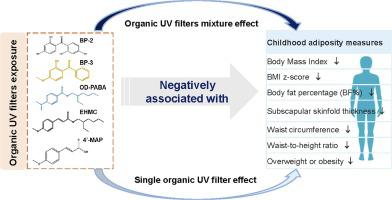Environment International ( IF 11.8 ) Pub Date : 2021-10-04 , DOI: 10.1016/j.envint.2021.106912 Pengpeng Wang 1 , Yanran Huang 2 , Yingya Zhao 1 , Yuhan Zhou 1 , Hang Wang 1 , Liyi Zhang 1 , Huijing Shi 1 , Kelvin Sze-Yin Leung 3 , Yunhui Zhang 1

|
Background
UV filters are emerging contaminants with endocrine disrupting effects, but little is known about their health effects, especially for children.
Objective
To assess the association between multiple organic UV filters exposure and adiposity measures and by gender in peripubertal children.
Methods
This prospective follow-up study included 327 children aged 7–15 years old. Urinary organic UV filters including benzophenone derivatives (BP-2, BP-3), octyl dimethyl para-aminobenzoic acid (OD-PABA), ethylhexyl methoxycinnamate (EHMC) and its metabolite (4-MCA and 4′-MAP) were quantified. Six adiposity biometrics including height, weight, waist and hip circumferences, and triceps and subscapular skinfold thickness were measured with 1.5-year duration. The Bayesian kernel machine regression method was used to estimate the associations of UV filters mixture with adiposity measurements, and longitudinal analyses were then considered to further evaluate the associations between individual UV filters and trajectories of growth development using linear mixed models or generalized linear mixed models.
Results
Exposure to mixture of UV filters was negatively associated with most adiposity measurements, with a reduction of 1.399 kg/m2 (95% CI: −2.246 to −0.551 kg/m2) in BMI, 0.674 (95% CI: −1.045 to −0.304) in BMI z-score, 0.033 BF% (95% CI: −0.053 to −0.013), and 2.301 mm (95% CI: −3.823 to −0.78) in subscapular skinfold thickness at baseline, comparing the 75th percentile to the 25th level of UV filters mixture exposure. Consistent associations were found at follow-up. Both baseline and follow-up results suggested that EHMC was identified as the most important contributor to lower adiposity measurements, which was also confirmed by linear mixed models in longitudinal analyses. No significant effects were found in girls.
Conclusion
This study found that childhood organic UV filters exposure was negatively associated with adiposity measures in peripubertal boys, but not girls.



























 京公网安备 11010802027423号
京公网安备 11010802027423号